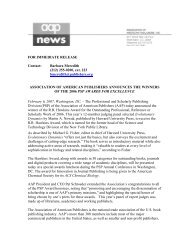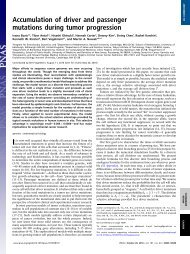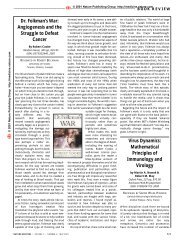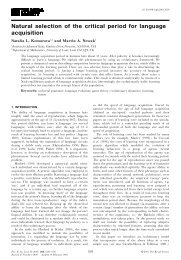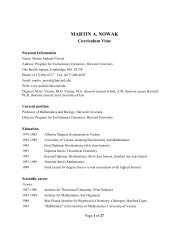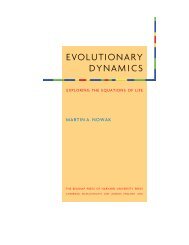Language Evolution and Information Theory - Joshua Plotkin
Language Evolution and Information Theory - Joshua Plotkin
Language Evolution and Information Theory - Joshua Plotkin
Create successful ePaper yourself
Turn your PDF publications into a flip-book with our unique Google optimized e-Paper software.
J. theor. Biol. (2000) 205, 147}159<br />
doi:10.1006/jtbi.2000.2053, available online at http://www.idealibrary.com on<br />
<strong>Language</strong> <strong>Evolution</strong> <strong>and</strong> <strong>Information</strong> <strong>Theory</strong><br />
JOSHUA B. PLOTKIN* AND MARTIN A. NOWAK<br />
Institut for Advanced Study, Princeton, NJ 08540, ;.S.A.<br />
(Received on 21 October 1999, Accepted in revised form 24 March 2000)<br />
This paper places models of language evolution within the framework of information theory.<br />
We study how signals become associated with meaning. If there is a probability of mistaking<br />
signals for each other, then evolution leads to an error limit: increasing the number of signals<br />
does not increase the "tness of a language beyond a certain limit. This error limit can be<br />
overcome by word formation: a linear increase of the word length leads to an exponential<br />
increase of the maximum "tness. We develop a general model of word formation <strong>and</strong><br />
demonstrate the connection between the error limit <strong>and</strong> Shannon's noisy coding theorem.<br />
2000 Academic Press<br />
1. Introduction<br />
If we want to underst<strong>and</strong> the evolution of<br />
primitive communication, then we should "rst<br />
consider how signals acquire speci"c meanings.<br />
In other words, we should explore how evolution<br />
can lead to an association between signals <strong>and</strong><br />
objects of the world. Here &&object'' is used in<br />
a very broad sense to include everything which<br />
can be referred to.<br />
In previous papers, we have used evolutionary<br />
game theory to study this question (Nowak<br />
& Krakauer, 1999; Nowak et al., 1999a). We have<br />
assumed that communication is of bene"t to both<br />
speaker <strong>and</strong> listener. Correct communication<br />
leads to a payo!. Each individual is characterized<br />
by two matrices. The active matrix contains the<br />
probabilities that a speaker will use a certain<br />
signal when attempting to communicate about<br />
a certain object. The passive matrix contains the<br />
probabilities that a listener will associate a speci-<br />
*Author to whom correspondence should be addressed.<br />
E-mail: plotkin@ias.edu<br />
"c signal with a speci"c object. If there is a possibility<br />
of mistaking signals for each other then we<br />
obtain an error limit. Using more <strong>and</strong> more signals<br />
cannot increase the "tness of a language<br />
beyond a certain limit. In other words, natural<br />
selection will design a communication system<br />
that has only a small number of signals referring<br />
to a few important concepts. It seems that this is<br />
the case for animal communication, while human<br />
language is (almost) unlimited.<br />
The mechanism that can overcome the error<br />
limit is word formation. We "nd that linearly<br />
increasing word length can lead to exponentially<br />
increasing maximum "tness (Nowak et al.,<br />
1999b). The evolution of word formation is a<br />
transition from an analog to a digital communication<br />
system. All human languages use a limited<br />
number of phonemes to generate a large<br />
number of words. Moreover, word formation<br />
is probably unique to human communication<br />
(Pinker, 1995; Miller, 1991). Bird song is certainly<br />
combinatorial as well, but the interpretation<br />
of bird song is most likely not combinatorial<br />
(Marler, 1970; Hauser, 1996).<br />
0022}5193/00/130147#13 $35.00/0 2000 Academic Press
148 J. B. PLOTKIN AND M. A. NOWAK<br />
An important feature which has been missing<br />
from previous investigations is the connection<br />
between language evolution <strong>and</strong> information theory<br />
as conceived by Shannon & Weaver (1949).<br />
We build this bridge in the present paper. We will<br />
develop a more realistic model of word formation<br />
<strong>and</strong> discuss how the payo! in our evolutionary<br />
language game is related to Shannon's error<br />
probability <strong>and</strong> to the capacity of a channel.<br />
Speci"cally, we show the relationship between<br />
Shannon's noisy coding theorem <strong>and</strong> our "nding<br />
that word formation can overcome the error<br />
limit.<br />
<strong>Information</strong> theory is a mathematical discipline<br />
devoted to a precise de"nition <strong>and</strong> underst<strong>and</strong>ing<br />
of &&information'' in the vernacular<br />
sense. Following the seminal works of Shannon,<br />
information theorists have used notions from<br />
probability theory to de"ne uncertainty <strong>and</strong> information.<br />
<strong>Information</strong> theory addresses such<br />
questions as the maximum rate at which information<br />
can be transfered over a noisy (or imperfect)<br />
channel. In particular, a coding system (e.g. repeating<br />
each message "ve times) may be used to<br />
increase the "delity of a noisy channel. Shannon's<br />
noisy coding theorem quanti"es the bene"ts<br />
which coding systems may confer on an otherwise<br />
noisy communication channel.<br />
Although information theory has been widely<br />
applied in today's &&information age'', it has<br />
seldom been used*nor was it conceived*in the<br />
setting of language evolution. Despite this fact,<br />
we shall see that Shannon's formalism provides<br />
an excellent framework for considering language<br />
evolution, <strong>and</strong> especially word formation. In fact,<br />
when properly placed in this framework, the theory<br />
of language evolution should bene"t from the<br />
insights of information theorists over the past 50<br />
years.<br />
This paper contains seven sections. In Section<br />
2, we will outline the basic model of language<br />
evolution. In Section 3, we present a new approach<br />
for describing word formation. In Section<br />
4, some basic concepts of information theory are<br />
discussed. In Section 5, we compare these concepts<br />
of information theory, in particular Shannon's<br />
noisy coding theorem, with our model of<br />
word formation. In Section 6, we present a speci-<br />
"c example of a very simple communication<br />
system <strong>and</strong> analyse it from the perspective of<br />
language evolution <strong>and</strong> information theory.<br />
Section 7 is a short conclusion.<br />
2. Evolving Arbitrary Signals<br />
Consider a population of individuals who can<br />
communicate via signals. Signals may include<br />
gestures, facial expressions, or spoken sounds.<br />
We are interested how an arbitrary association<br />
between signals <strong>and</strong> &&objects'' can evolve.<br />
In the most simple model, each individual is<br />
described by an active matrix, P, <strong>and</strong> a passive<br />
matrix Q (Hurford et al., 1998). The entry<br />
P denotes that the probability that the individual,<br />
as a speaker, will refer to object i by using<br />
<br />
signal j. The entry Q denotes the probability<br />
<br />
that the individual, as a listener, will interpret<br />
signal j as referring to object i. Both P <strong>and</strong> Q are<br />
stochastic matrices; their entries lie in [0, 1], <strong>and</strong><br />
their rows each sum to one. The &&language'' of an<br />
individual, ¸"(P, Q), is de"ned by these two<br />
matrices.<br />
When one individual using ¸"(P, Q) communicates<br />
with another individual using ¸"<br />
(P, Q), we de"ne the payo! as the number of<br />
objects communicable between the individuals,<br />
weighted by their probability of correct communication.<br />
Thus, the payo! of ¸ vs. ¸ is given by<br />
F(¸, ¸)" 1 <br />
P Q #P Q .<br />
2 <br />
<br />
There are n objects <strong>and</strong> m signals. Loosely speaking,<br />
this payo! function re#ects the total amount<br />
of information that ¸ can convey to ¸, <strong>and</strong> vice<br />
versa. In this basic model, any possible miscommunication<br />
results from a discrepancy between<br />
the signal}object associations of the speaker <strong>and</strong><br />
the listener. The maximum possible payo! to two<br />
individuals who share a common language is the<br />
smaller of n or m.<br />
2.1. TRANSMISSION ERROR<br />
Miscommunication can arise from errors that<br />
occur during the transmission of a signal. Such<br />
&&transmission errors'' can be described by a signal-error<br />
matrix ;. The entry ; <br />
denotes the<br />
probability that, when a speaker sends signal i,<br />
the listener receives signal j. In this setting,
LANGUAGE EVOLUTION AND INFORMATION THEORY 149<br />
assuming that two individuals share a common<br />
language ¸"(P, Q), the payo! is de"ned by<br />
F(¸, ¸)" <br />
<br />
P ; Q . (1)<br />
<br />
<br />
Again, this payo! function re#ects the sum of the<br />
information content which a speaker can convey<br />
accurately to a listener <strong>and</strong> vice versa.<br />
2.2. THE ERROR LIMIT<br />
Let us now calculate the maximum payo! that<br />
a language, ¸, can achieve. Suppose n"m. The<br />
maximum payo! will be obtained if P <strong>and</strong> Q are<br />
identical permutation matrices. (A permutation<br />
matrix has a single 1 entry per row <strong>and</strong> column,<br />
all other entries being 0.) Without loss of generality,<br />
we set P <br />
"Q <br />
"1 for all i, <strong>and</strong> P <br />
"Q <br />
"0<br />
for all iOj. In this case, we obtain the payo!<br />
function<br />
F(¸, ¸)" <br />
; . <br />
<br />
The signal-error matrix, ;, can be constructed<br />
to re#ect the similarities of the signals. In particular,<br />
we denote the similarity between signal i <strong>and</strong><br />
signal j by s <br />
. We stipulate that s <br />
"1 <strong>and</strong><br />
s <br />
)1. The probability of mistaking signal i for<br />
signal j quanti"es how similar signal i is to j compared<br />
with all other signals: u <br />
"s <br />
/ <br />
s <br />
.In<br />
these terms, the "tness of a common language<br />
can be expressed as<br />
F(¸, ¸)" <br />
1<br />
.<br />
s<br />
<br />
We imagine that the signals of the language are<br />
embedded in some pre-compact metric space, X,<br />
<strong>and</strong> that d <br />
denotes the distance between signals<br />
i <strong>and</strong> j. The similarity between two signals, then,<br />
is a decreasing function of the distance s <br />
"f (d <br />
).<br />
It can be shown that in this situation the "tness is<br />
always bounded by some constant depending<br />
only on X <strong>and</strong> f, but not on n (Dress & Nowak,<br />
2000). In other words, even as the signal repertoire<br />
of a language increases, the "tness cannot<br />
exceed a "xed value.<br />
3. Word Formation<br />
In Nowak et al. (1999b), we demonstrated that<br />
word formation can overcome the constraint of<br />
the error limit. We considered languages whose<br />
basic signals consist of m phonemes. The words of<br />
the language were all assumed to be l-phonemes<br />
long. For simplicity, we also assumed that a language<br />
includes all possible m words in its lexicon.<br />
The similarity between words α <strong>and</strong> β was de-<br />
"ned by the product of the similarity of their<br />
phonemes. In other words,<br />
S(α, β)" <br />
s ,<br />
<br />
where α denotes the k-th phoneme of word α.<br />
Using this de"nition, we showed that the maximum<br />
"tness of the language increases exponentially<br />
with word length l. In this sense, word formation<br />
allows the language to overcome the error limit.<br />
We now develop a more general framework for<br />
word-based language. A language will be described<br />
by four components: a lexicon, anactive<br />
matrix P, a passive matrix Q, <strong>and</strong> a phoneme<br />
error-matrix
150 J. B. PLOTKIN AND M. A. NOWAK<br />
a stochastic mn matrix Q. The entry Q <br />
represents<br />
the probability that a listener who perceives<br />
the j-th word will interpret it as the i-th object.<br />
Finally, we must provide a description of<br />
transmission errors. As before, we use an mm<br />
word error-matrix ;. The entry ; <br />
denotes the<br />
probability that, when a speaker attempts to vocalize<br />
the i-th word, the listener perceives the j-th<br />
word. Notice that only the rows of ; corresponding<br />
to lexicon words matter; we have assumed<br />
that a speaker will never attempt to vocalize an<br />
improper vocabulary word (although a speaker<br />
may, in fact, utter a word outside of the lexicon<br />
via a transmission error).<br />
In strict analogy with previous models, the ;-<br />
matrix is built upon the similarity between the<br />
phonemes of which the words are comprised. In<br />
particular, we start with a stochastic mm phoneme<br />
error-matrix
LANGUAGE EVOLUTION AND INFORMATION THEORY 151<br />
maximum rate at which information about an<br />
input stream may be inferred by inspecting the<br />
output stream. (A more precise de"nition will be<br />
given in Section 6.) Given a channel < with capacity<br />
C(
152 J. B. PLOTKIN AND M. A. NOWAK<br />
Notice "rst that a Shannon-encoder may be expressed<br />
as a binary nm matrix P whose rows<br />
sum to one. The entry P <br />
indicates whether or<br />
not the encoder uses word j to denote object<br />
(or message) i. Similarly the decoder may be<br />
expressed as a binary mn matrix Q. The entry<br />
Q <br />
denotes whether or not the j-th word is included<br />
in the subset words decoded as the i-th<br />
codeword (or i-th message).<br />
In this setting, Shannon's codeword communication<br />
through a noisy channel is easily seen to be<br />
equivalent to our model for language. Shannon's<br />
alphabet Φ plays the role of the phonemes, the<br />
encoder plays the role of the active matrix, <strong>and</strong> the<br />
decoder the passive matrix. Shannon's &&codewords''<br />
are simply strings of phonemes. Similarly,<br />
the noisy channel < plays the role of the phoneme<br />
error matrix. Shannon's communication system is<br />
always deterministic; however, it requires that the<br />
matrices P <strong>and</strong> Q are binary. Notice that, when<br />
P is binary, there is an unambiguous one-to-one<br />
correspondence between lexicon words <strong>and</strong> objects.<br />
In this situation, the &&objects'' expressible in<br />
our original language model may be identi"ed<br />
with Shannon's codewords.<br />
In light of the equivalence of these two systems,<br />
it is important to relate the information-theoretic<br />
de"nition of error probability*whose behavior is<br />
described by Shannon's theorem <strong>and</strong> its converse*<br />
with our de"nition of language "tness. Such a relation<br />
will allow us to use Theorem 4.1 to derive the<br />
Thus, Shannon's theorem (together with its converse)<br />
reveals the maximal properties of FI (C).<br />
We will show that FI (C) is equivalent to the<br />
"tness of language in our evolutionary model.<br />
Thus, we claim<br />
FI (C)"F(¸, ¸).<br />
The proof of this statement is little more than an<br />
exercise in unraveling de"nitions. We start with<br />
the de"nition of FI :<br />
FI (C)"n[1!e(C)]<br />
<br />
"n 1!1 Pr(communication error<br />
n<br />
<br />
w transmitted) <br />
<br />
"n! <br />
(1!Pr(no communication error<br />
<br />
w transmitted))<br />
<br />
" <br />
Pr(no communication error<br />
<br />
w transmitted).<br />
<br />
Recall that in Shannon's codeword system,<br />
P <strong>and</strong> Q are binary matrices whose rows sum to<br />
1. Therefore, given w3C, P "1 only when<br />
<br />
α"w. Thus, we may rewrite the last equality<br />
above as follows:<br />
FI (C)" <br />
P Pr(no communication errorα transmitted).<br />
α3Φ <br />
<br />
maximal "tness of our word-based model.<br />
Towards this end, consider the information-theoretic<br />
expression FI (C)"C(1!e(C))"n(1!e(C)).<br />
By Shannon's theorem, given a channel < with<br />
non-zero capacity, we can "nd a sequence of<br />
codes C <br />
with linearly increasing codeword<br />
length <strong>and</strong> with exponentially increasing FI (C).<br />
In order to calculate the probability of correct<br />
communication when α is transmitted, we consider<br />
all possible outputs β from the noisy channel,<br />
weighted by their respective probabilities.<br />
For each output β, correct communication occurs<br />
only if β is decoded as codeword w <br />
. Thus,<br />
we derive the equations<br />
FI (C)" <br />
<br />
<br />
α3Φ<br />
" <br />
<br />
<br />
α3Φ<br />
P Pr(β receivedα transmitted)Pr(β is decoded as codeword w )<br />
<br />
β3Φ<br />
<br />
P Pr(β receivedα transmitted)Q .<br />
<br />
β3Φ
LANGUAGE EVOLUTION AND INFORMATION THEORY 153<br />
Finally, we must calculate the probability that,<br />
upon input α into the noisy channel, we receive<br />
output β. The noisy channel produces its output<br />
phoneme-by-phoneme (or &&letter by letter'').<br />
Therefore, the probability we want equals the<br />
product of the probabilities that each phoneme of<br />
α will be transmitted as the respective phoneme of<br />
β. Such quantities are given by the channel<br />
matrix
154 J. B. PLOTKIN AND M. A. NOWAK<br />
Notice that the columns of P with non-zero<br />
entries correspond to proper vocabulary words.<br />
In other words, when a speaker wants to communicate<br />
food, there is no chance that he will<br />
attempt to use a word outside of his language's<br />
lexicon. The active matrix represents the<br />
speaker's association between objects <strong>and</strong> proper<br />
vocabulary words.<br />
6.3. THE TRANSMISSION ERROR MATRICES<br />
Despite the form of the active matrix, there is<br />
always a chance that when trying to communicate<br />
an object, the perceived output will not fall in<br />
the lexicon. This phenomenon arises from errors<br />
in vocalizing the intended word or hearing the<br />
output correctly. Such a phenomenon is a transmission<br />
error, as opposed to a interpretation error,<br />
<strong>and</strong> it is quanti"ed by the word error-matrix<br />
;.<br />
In order to specify ;, we must "rst de"ne the<br />
phoneme error-matrix
LANGUAGE EVOLUTION AND INFORMATION THEORY 155<br />
FIG. 2. Schematic diagram of the embedding of phonemes<br />
Φ"a, m, p into the metric space X"[0, 1]. Once<br />
embedded, phoneme similarity is de"ned by a decreasing<br />
function of distance.<br />
6.4. THE PASSIVE MATRIX<br />
Finally, we must specify the passive matrix Q.<br />
This matrix provides, for each possible perceived<br />
output word, the probability of interpreting that<br />
word as each respective object. For example,<br />
Q aa,mother denotes the probability of interpreting<br />
perceived output word aa as the object mother.<br />
Given P <strong>and</strong> ;, what is a reasonable choice of<br />
listening matrix Q?<br />
We will soon derive the optimal, deterministic<br />
choice of Q. For now, however, we follow a reasonable<br />
rule of interpretation: a listener should<br />
interpret perceived output word α as object i with<br />
a probability which equals the probability that,<br />
when trying to communicate object i, the perceived<br />
output would be α. In other words, we set<br />
Q <br />
"Pr(output αi transmitted). For example,<br />
we set Q aa,mother equal to the chance of producing<br />
output aa when trying to communicate mother.<br />
In particular, this probability is given by<br />
(1!2ε); ma,aa #ε; mm,aa #ε; pa,aa +0.05(1!2ε)<br />
#0.00ε#0.02ε+0.05!0.09ε. Following this<br />
rule alone, however, the rows of the resulting<br />
Q matrix do not necessarily sum to one. Thus, we<br />
normalize each row to derive the following, nondeterministic<br />
Q-matrix:<br />
Mother Food Father<br />
aa 0.73!1.2ε 0.05#0.85ε 0.22#0.34ε<br />
am 0.09#0.73ε 0.89!1.65ε 0.03#0.92ε<br />
ap 0.09#0.73ε 0.88!1.65ε 0.03#0.92ε<br />
ma 0.73!1.2ε 0.05#0.85ε 0.22#0.34ε<br />
Q" mm 0.09#0.73ε 0.88!1.65ε 0.03#0.92ε<br />
mp 0.09#0.73ε 0.88!1.65ε 0.03#092ε<br />
pa 0.21#0.36ε 0.01#0.96ε 0.77!1.3ε<br />
pm 0.07#0.79ε 0.68!1.04ε 0.25#0.25ε<br />
pp 0.07#0.79ε 0.68!1.04ε 0.25#0.25ε.<br />
(3)<br />
6.5. THE PAYOFF<br />
Since the language ¸"(P, Q,
156 J. B. PLOTKIN AND M. A. NOWAK<br />
deterministic matrices. Also notice that the<br />
minimum "tness occurs when ε"1/3; in this<br />
situation each speaker has an indiscriminate<br />
association between objects <strong>and</strong> lexicon words.<br />
6.6. IN THE CONTEXT OF INFORMATION THEORY<br />
We now reconsider the example in the context<br />
of information theory. The phoneme errormatrix<br />
< now plays the role of the channel<br />
matrix. Similarly, we use the original lexicon as<br />
the code-words. The encoder <strong>and</strong> decoder, however,<br />
must now be binary. Therefore, in a strict,<br />
information theoretic context, we must take<br />
ε"0. In this context, we should also use deterministic,<br />
maximum likelihood decoding, as in the<br />
proof of Shannon's theorem. Speci"cally, Q must<br />
decode an output word α as that particular<br />
codeword i which maximizes the conditional<br />
probability Pr(output αi transmitted). Recall<br />
that in eqn (3) we de"ned Q "Pr(output αi<br />
<br />
transmitted), <strong>and</strong> normalized each row. Therefore,<br />
the maximum likelihood decoder simply<br />
replaces each row of the non-deterministic Q with<br />
zeroes, except for the largest entry in the row.<br />
More explicitly, for each α3Φ, the deterministic,<br />
maximum-likelihood decoder Q satis"es<br />
"1<br />
Q<br />
<br />
when α maximizes<br />
Pr(output αi transmitted)<br />
0 otherwise.<br />
1 when α maximizes<br />
"<br />
0 otherwise.<br />
β3Φ<br />
P ; <br />
In our particular example, when ε"0 we have<br />
the following maximum-likelihood decoder Q:<br />
Mother Food Father<br />
aa 1 0 0<br />
am 0 1 0<br />
ap 0 1 0<br />
(Notice, for example, that mp is decoded<br />
a food (mm) as opposed to mother (ma). This<br />
makes sense given that p is phonetically closer to<br />
m than to a.)<br />
When ε"0 <strong>and</strong> when we use maximum-likelihood<br />
decoding, we calculate that F(¸, ¸)+2.35.<br />
This maximum "tness is signi"cantly larger than<br />
1.96, which was the "tness obtained via the nondeterministic<br />
encoder of eqn (3). In fact, as ε varies,<br />
we can evaluate the "tnesses obtained via the<br />
maximum-likelihood vs. the non-deterministic<br />
encoders. A graph of these "tnesses is shown in<br />
Fig. 4.<br />
Notice that it is always better (except when<br />
ε"1/3) to use the Shannon-type decoder Q<br />
than the non-deterministic matrix de"ned in<br />
eqn (3). This is a graphic illustration of the optimality<br />
ensured by Shannon's theorem.<br />
6.7. THE CAPACITY CALCULATION<br />
In this section, we compute the capacity of<br />
the 33 phoneme error-matrix
LANGUAGE EVOLUTION AND INFORMATION THEORY 157<br />
where H denotes the entropy of a source. The<br />
entropy of a discrete source I with probability<br />
distribution (p <br />
,2, p <br />
) is de"ned as H(I)"<br />
! <br />
p <br />
log(p <br />
). See Welsh (1988) for a description<br />
of entropy.<br />
In our particular example, a source I is determined<br />
by a discrete probability distribution<br />
(x, y, z), x#y#z"1, where x denotes the probability<br />
that the source will emit letter a, y denotes<br />
the probability for m, <strong>and</strong> z for p. The output<br />
stream J is calculated as follows; the probability<br />
of an a is x< <br />
#y< <br />
#z< <br />
, <strong>and</strong> similarly for<br />
the other two letters. The stream (I, J) has nine<br />
possible &&letters'': a followed by a, a followed by<br />
m, etc. These probabilities are given by x< <br />
,<br />
x< <br />
, etc.<br />
Once the probability distributions for I, J,<br />
<strong>and</strong> (I, J) have been expressed in terms of<br />
(x, y, z), we must maximize the function<br />
H(I)#H(J)!H(I, J) over all input distributions<br />
for I. This maximization amounts to<br />
nothing more than a straightforward calculus<br />
problem via Lagrange multipliers. The resulting<br />
answer is given by<br />
C(
158 J. B. PLOTKIN AND M. A. NOWAK<br />
FIG. 5. Graph of the average payo! in a population of<br />
individuals during the course of simulated language evolution.<br />
The population begins with non-deterministic decoding<br />
<strong>and</strong> evolves towards maximum-likelihood decoding.<br />
This evolution towards determinism is re#ected by the average<br />
payo! of the population, which ascends towards the<br />
Shannon limit of 2.35. Thus, the long-term, complex dynamics<br />
of language evolution are predicted by information<br />
theory. ( ----) Shannon limit; (**) simulation.<br />
complicated <strong>and</strong> noisy, we can still underst<strong>and</strong><br />
their long-term behavior via the bounds imposed<br />
by information theory.<br />
7. Conclusions<br />
We have compared models of language evolution<br />
with concepts from information theory. In<br />
particular, there is a connection between Shannon's<br />
noisy coding theorem <strong>and</strong> our results on<br />
word formation. Shannon's theorem states that,<br />
for a given noisy channel, there exists a sequence<br />
of codes with linearly increasing codeword<br />
length such that the probability of transmission<br />
error decreases exponentially. Our<br />
result on word formation states that, for a given<br />
phonemic error matrix, the maximum "tness of<br />
a language increases exponentially with word<br />
length. We demonstrated that Shannon's error<br />
probability is inversely proportional to our "tness<br />
function. Hence, the equivalence becomes<br />
obvious.<br />
Although the maximum "tness of a language<br />
increases with word length, evolution will not<br />
lead to a run-away sequence of languages with<br />
longer <strong>and</strong> longer words. Clearly, there are natural<br />
restraints on this tendency: as word length<br />
increases, memorization di$culties increase <strong>and</strong><br />
the rate of communication decreases.<br />
Shannon's theory requires a deterministic encoder<br />
<strong>and</strong> decoder (equivalent to binary P <strong>and</strong><br />
Q matrices in our notation). Any errors thus<br />
result from noisy transmission, which is equivalent<br />
in our terms to acoustic errors during communication:<br />
the sender emits signal A, but the<br />
receiver hears signal B. We believe that word<br />
formation was the crucial evolutionary invention<br />
to overcome this kind of transmission error.<br />
Instead of increasing the number of phonemes<br />
in a language, our ancestors invented a combinatorial<br />
signaling system. In this sense, word<br />
formation compensates for errors in signal<br />
transmission.<br />
There are, however, other kinds of errors<br />
which are not captured by Shannon's basic<br />
model. These are coordination errors between<br />
the implementation of a signal by the sender <strong>and</strong><br />
the interpretation of a signal by the receiver. We<br />
believe that these errors cannot be overcome by<br />
word formation per se, but that they instead<br />
require a sophisticated organization of the mental<br />
lexicon <strong>and</strong>, importantly, the invention of<br />
syntax. As the size of the mental lexicon reaches<br />
some memory capacity it becomes feasible to<br />
represent every message by an individual word.<br />
Instead, sentences comprised of individual words<br />
are required. Hence, there should be an error<br />
limit for words which is overcome by the use<br />
of sentences. This topic*the evolution of syntax*requires<br />
further investigation (Nowak et al.,<br />
2000).<br />
REFERENCES<br />
DRESS, A.&NOWAK, M. A. (2000) (in preparation).<br />
GALLAGER, R. G. (1968). <strong>Information</strong> ¹heory <strong>and</strong> Reliable<br />
Communication. New York: Wiley.<br />
HAUSER, M. (1996). ¹he <strong>Evolution</strong> of Communication. Cambridge,<br />
MA: MIT Press.<br />
HOFBAUER, J.&SIGMUND, K. (1998). <strong>Evolution</strong>ary Games<br />
<strong>and</strong> Population Dynamics. Cambridge: Cambridge University<br />
Press.<br />
HURFORD, J., STUDDERT-KENNEDY, M. & KNIGHT, C.<br />
(1998). Approaches to the <strong>Evolution</strong> of ¸anguage. Cambridge:<br />
Cambridge University Press.<br />
MARLER, P. (1970). Birdsong <strong>and</strong> speech development:<br />
could there be parallels? Am. Sci. 58, 669}673.<br />
MILLER, G. (1991). ¹he Science of =ords. New York: Scienti"c<br />
American Library.<br />
NOWAK, M. A. & KRAKAUER, D. C. (1999a). The<br />
<strong>Evolution</strong> of <strong>Language</strong>. Proc. Nat. Acad. Sci. ;.S.A. 96,<br />
8028.<br />
NOWAK, M. A., PLOTKIN,J.B.&KRAKAUER, D. C. (1999a).<br />
The <strong>Evolution</strong>ary <strong>Language</strong> Game. J. theor. Biol. 200,<br />
147}162.
LANGUAGE EVOLUTION AND INFORMATION THEORY 159<br />
NOWAK, M. A., KRAKAUER, D.C.&DRESS, A. (1999b). An<br />
error-limit for the evolution of language. Proc. Roy. Soc.<br />
¸ondon B 266, 2131}2136.<br />
NOWAK, M. A., PLOTKIN, J.B.&JANSEN, V. A. A. (2000).<br />
The evolution of syntactic communication. Nature 404,<br />
495}498.<br />
PINKER,S.(1995).¹he ¸anguage Instinct. New York: Penguin.<br />
SHANNON, C. E. (1948). A Mathematical <strong>Theory</strong> of Communication.<br />
Bell System ¹echnical Journal 27, 379}423, 623}656.<br />
SHANNON, C.E.&WEAVER, W. (1949). ¹he Mathematical<br />
¹heory of Communication. Illinois: University of Illinois<br />
Press.<br />
VAN DER LUBBE, J. (1988). <strong>Information</strong> ¹heory. Cambridge:<br />
Cambridge University Press.<br />
WELSH, D. (1988). Codes <strong>and</strong> Cryptography. Oxford University<br />
Press.<br />
WOLFOWITZ, J. (1961). Coding theorems of information<br />
theory. Berlin: Springer-Verlag.




